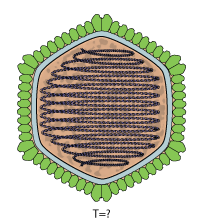Portogloboviridae
Portogloboviridae is a family of archaeal viruses within the order Ligamenvirales. This family of viruses infects archaea, specifically members of the phylum Euryarchaeota. The family was first described in 2017 and includes viruses with unique structural and genetic characteristics.
Taxonomy[edit | edit source]
The family Portogloboviridae is classified under the order Ligamenvirales. It currently includes a single genus, Portoglobovirus, which contains one species, Portoglobovirus portoglobus.
Structure[edit | edit source]
Portogloboviridae viruses have a unique morphology. They possess a linear, double-stranded DNA genome. The virions are non-enveloped and have an icosahedral capsid structure. The capsid is composed of proteins that form a protective shell around the viral genome.
Genome[edit | edit source]
The genome of Portogloboviridae viruses is linear and double-stranded, with a length of approximately 20-30 kilobases. The genome encodes several proteins, including those involved in DNA replication, transcription, and capsid formation. The genetic organization of these viruses is distinct from other archaeal viruses, reflecting their unique evolutionary lineage.
Life Cycle[edit | edit source]
Portogloboviridae viruses infect Euryarchaeota hosts. The life cycle begins with the attachment of the virus to the host cell surface, followed by the injection of the viral genome into the host cell. The viral DNA is then replicated and transcribed by the host's machinery. New virions are assembled in the host cell and released through cell lysis, completing the infection cycle.
Host Range[edit | edit source]
The primary hosts for Portogloboviridae viruses are members of the phylum Euryarchaeota. These archaea are commonly found in extreme environments, such as high-temperature hydrothermal vents and high-salinity environments.
Significance[edit | edit source]
The study of Portogloboviridae viruses provides insights into the diversity and evolution of archaeal viruses. Understanding their structure, genome organization, and life cycle can help elucidate the mechanisms of virus-host interactions in extreme environments.
See Also[edit | edit source]
References[edit | edit source]
External Links[edit | edit source]
Lua error in mw.title.lua at line 318: bad argument #2 to 'title.new' (unrecognized namespace name 'Portal').
Navigation: Wellness - Encyclopedia - Health topics - Disease Index - Drugs - World Directory - Gray's Anatomy - Keto diet - Recipes
Search WikiMD
Ad.Tired of being Overweight? Try W8MD's physician weight loss program.
Semaglutide (Ozempic / Wegovy and Tirzepatide (Mounjaro / Zepbound) available.
Advertise on WikiMD
WikiMD is not a substitute for professional medical advice. See full disclaimer.
Credits:Most images are courtesy of Wikimedia commons, and templates Wikipedia, licensed under CC BY SA or similar.Contributors: Prab R. Tumpati, MD

